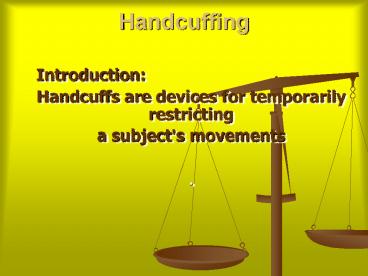Handcuffing - PowerPoint PPT Presentation
Title:
Handcuffing
Description:
that the officer is justified in handcuffing the subject: ... a subject who will not submit to being handcuffed. Control subject first, then handcuff ... – PowerPoint PPT presentation
Number of Views:13512
Avg rating:3.0/5.0
Title: Handcuffing
1
Handcuffing
- Introduction
- Handcuffs are devices for temporarily restricting
- a subjects movements
- .
2
Handcuff Maintenance
3
Nomenclature
4
Single Bar
5
Double Bar
6
Single Bar Teeth (ratchet)
7
Hinge rivet
8
Keyways
9
Double-Lock Mechanism
10
Pawl
11
Swivel
12
Chain
13
Key
14
Cleaning andDecontamination
15
Mechanical Failures
16
Keys
17
Loading and Wearing
18
Loading
19
Location on the Officer
20
Liabilities of Handcuff Application
21
- Situations
- that the officer is justified in handcuffing the
subject
22
- 1.) When the subject has committed a crime
23
- 2.) When the subject
- is an
- escape risk
24
- 3.) When the subject is a
- safety hazard.
25
- Keyhole positioning
26
- Double-locking
- handcuffs will prevent subject injury
27
- Types of Subjects
28
- 1. Totally cooperative
29
- 2. Potentially Uncooperative
- a subject who may resist at the first
opportunity.
30
3. Totally uncooperative
- a subject who will not submit to being
handcuffed. Control subject first, then handcuff
31
- Tactical Considerations
- Tactical handcuffing
- is a technique which affords an officer a higher
level of control over a subject during the
handcuffing procedure by applying the tactical
elements of
32
- Approach to contact
- officer uses reactionary gap
33
Control upon touch
- in order to defeat expect-ed resistance upon
first touch
34
- Speed of application
- to diffuse aggression or actions which may lead
to aggression
35
Grip
36
The Draw
37
Pistol grip
38
Pistol grip
- Keep index, middle, and ring fingers in between
the cuffs
39
Single Bars Forward
40
Keyways in the palm of your hand
41
Positioning Procedures
42
- Verbal Control
43
- Position the subject
- with clear and concise verbal commands.
44
- Suggested Commands
45
- Standing
46
- 1. Youre under arrest.2. Hands all the way
up, spread your fingers.3. Turn around
slowly. Visual inspection for weapons4. Face
away from me.5. Spread your feet apart,
further apart.6. Toes out.
47
- 7. Extend your arms straight out to your side,
like an airplane - point your thumbs down. - 8. Bend forward from the waist.
- Slowly bring your hands behind your back, thumbs
up. - Interlock your fingers
- 10. Look to left/right.
- 11. Dont move.
48
Kneeling
49
- 1. Youre under arrest.
- 2. Hands all the way up, spread your fingers.
- 3. Turn around slowly. Visual inspection for
weapons - 4. Face away from me.
- 5. Kneel down on one knee.
- 6. Kneel down on the other knee.
50
- 7. Hands extended out to your side.
- 8. Cross your ankles.
- 9. Extend your arms straight out to your side,
shoulder high - point your thumbs down. - 10.Bend forward at the waist.
- 11.Slowly bring your hands behind your back,
thumbs up, interlock your fingers - 12.Look to left/right.
- 13.Dont move.
51
Prone
52
- 1. Youre under arrest.
- 2. Hands all the way up, spread your fingers.
- 3. Turn around slowly. Visual inspection for
weapons - 4. Face away from me.
- 5. Kneel down on one knee.
- 6. Kneel down on both knees.
53
- 7. Walk your feet back towards me and Lie down.
- 8. Extend your arms straight out to your side,
shoulder high - point your thumbs down. - 9. Cross your ankles, bend your knees.
- 10.Slowly bring your hands behind your back,
thumbs up, interlock your fingers. - 11.Look to left/right.
- 12.Dont move.
54
- Wall Positions
55
- 1. The use of cars or walls are not necessarily
the best way to control the subject. The subject
chooses to resist he can use walls, cars, etc. as
balance and gain power by pushing off. Officers
normally use this technique to corner or
confine the subject.
56
- 2. Standing - the subjects toes should be placed
against the wall.
57
- 3. Kneeling - the subjects knees should be
placed against the wall.
58
Approach Procedure
59
- Avoid
- fully entering the
- Reactionary Gap
60
- Approach from
- Relative Position
- 2
61
Reactionary Gap
- Personal Zone
62
- Extend your arms while applying handcuffs to
maintain extra distance and to increase the
peripheral field of vision.
63
- Always be
- mentally prepared
- for
- sudden resistance
64
- Expect resistance after
- handcuffing the first hand if the subject is
under the influence of alcohol - (Croft Study, et al)
65
Handcuffing Positions
- 1. Standing Cuffing2. Kneeling Cuffing3. Prone
Cuffing
66
Takedown with Handcuffs
- Wristlocks
67
Awareness During Handcuffing
68
- A. Upon approaching a subject to handcuff, the
officer should stay outside the reactionary gap.
By doing so, if resistance is encountered, the
officer has the option of penetrating the gap to
obtain control, or disengaging contact.
69
Reactionary Gap
1
1
- Personal Zone
70
The officer should always be mentally prepared
for resistance
71
Always double lock handcuffs except when
tactically hazardous.
72
- Check tightness of handcuffs
- using the width of the little finger.
73
- If a subject complains of handcuff tightness,
- check handcuffs and document complaint.
74
Moving the subject to a standing position
75
One officer stand
76
Never pick a subject up by the handcuffs.
77
Removing the Handcuffs
78
Officer Power Stance
79
Remove in reverse order
80
Grip Chain
81
Verbal Commands to control hands
82
Close first cuff before going to the second
cuff.































